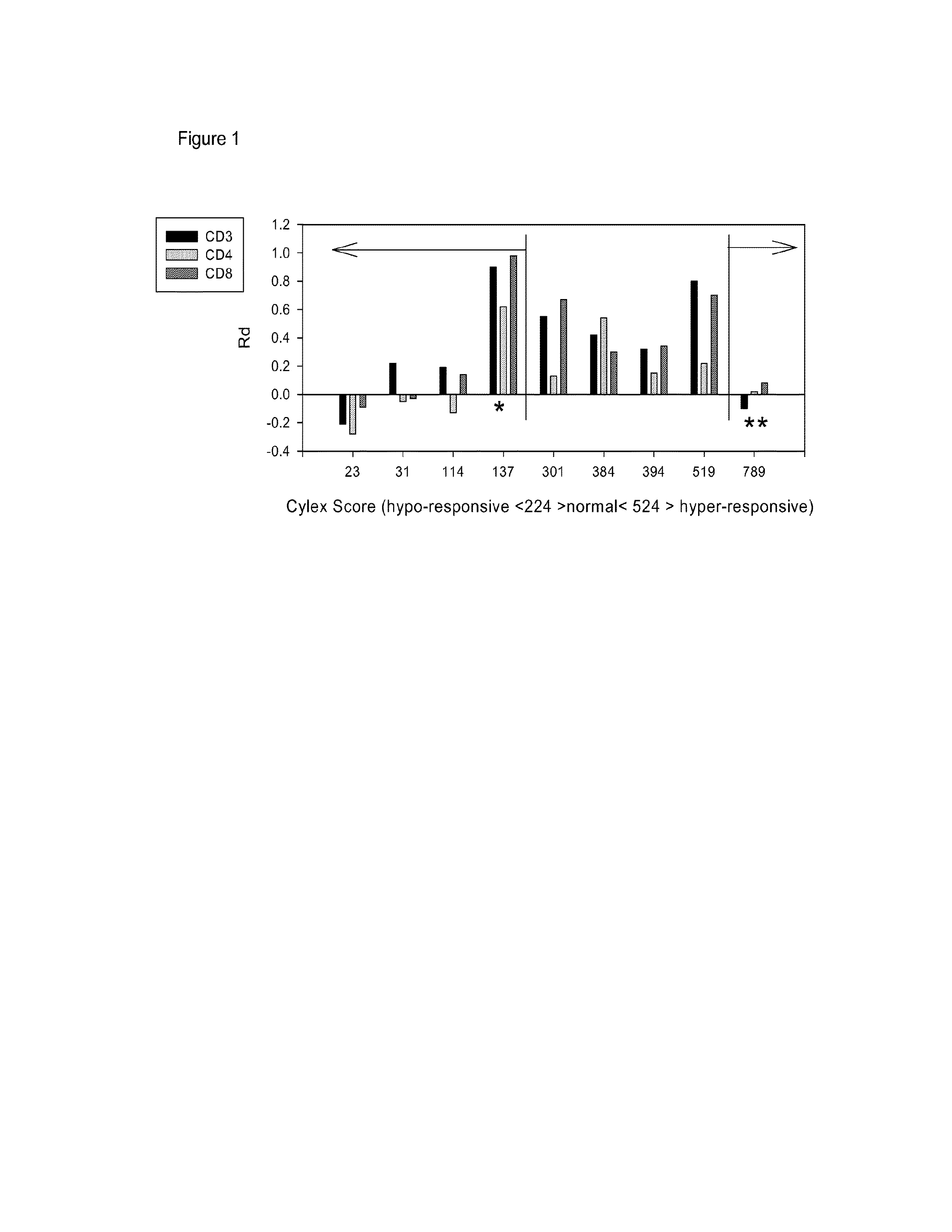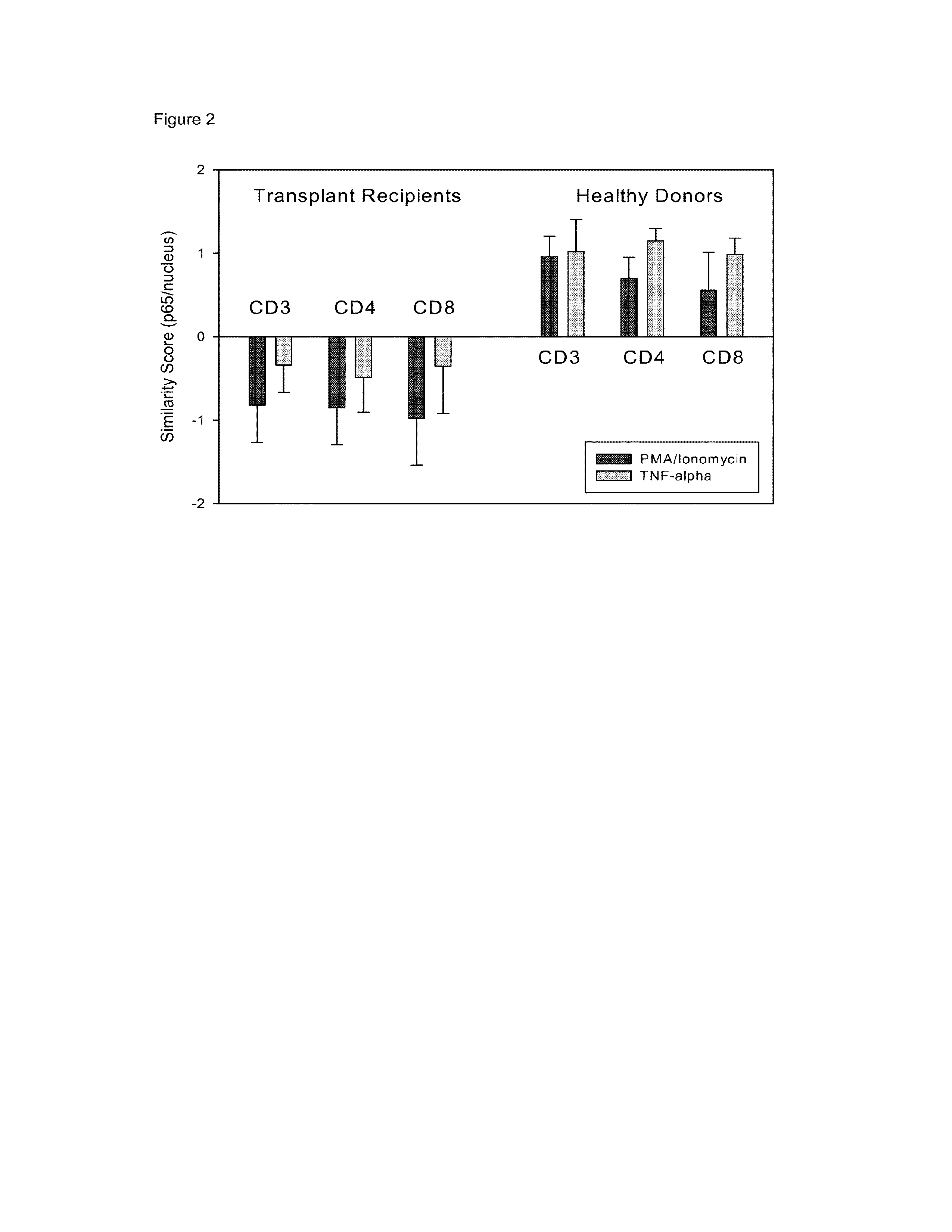Method of evaluating immunosuppression
a immunosuppression and immunosuppression technology, applied in the field of immunosuppression determination, can solve the problems of increasing the rate of infections and cancers, increasing the risk factors for cardiovascular risk factors and bone diseases, and life-long anti-rejection therapy has many adverse effects, so as to achieve less nuclear translocation of nfb, small similarity score, and high negative similarity score
- Summary
- Abstract
- Description
- Claims
- Application Information
AI Technical Summary
Benefits of technology
Problems solved by technology
Method used
Image
Examples
example 1
[0058]We measured the degree to which NFκB translocation in peripheral T cells was impaired by immune-suppressive therapy using a commercially available imaging cell flow cytometer (Amnis Corporation, Seattle, Wash.).
[0059]Peripheral blood cells from 9 transplant recipients were isolated, stimulated in culture with PMA / ionomycin (30 min), stained for T cell surface markers and NFκB (p65) and the relative amount of nuclear NFκB in resting and activated CD3, CD4 and CD8 positive T-cell subsets was compared. Results were then correlated with clinical response (stable graft function, infections and rejections) and ImmuKnow assay results. The assay correlated well with results obtained in parallel using the commercially available ImmuKnow product according to manufacturer's instructions, (FIG. 1) but there were 2 major discrepancies. In one patient (** in FIG. 1), the ImmuKnow assay levels indicated heightened immunity yet the patient suffered from major viral infections. In this patient...
example 2
[0060]The assay described in Example 1 was modified to perform the stimulation and cell surface labeling in whole blood to enable the method to be performed in the normal environment of the cells and to permit faster performance of the assay. Using this approach, the immune response of 5 transplant patients as compared to 4 normal donors to stimulation to TNFα or PMA / ion was compared. The data depicted in FIG. 2 demonstrate that using a similarity score read-out for nuclear NFκB as a measure for immune response, a striking difference could be observed between the samples from normal donors and samples from transplant recipients undergoing immunosuppressive therapy. Thus, this Example unexpectedly demonstrates that the method of the invention is suitable analysis of the amount of nuclear NFkB using a procedure whereby immune cells are activated in whole blood.
example 3
[0061]The results presented in this Example were performed using a commercially available imaging cell flow cytometer (Amnis Corporation, Seattle, Wash.) as in Example 1. The materials and methods utilized to obtain the results presented in the Example are essentially as follows:
[0062]Protocol to measure the NF-κB and / or NFAT activation potential in immunophenotypically defined cell populations: Obtain peripheral blood sample in sodium heparin container. Keep PBL sample at ambient room temperature. Prepare sufficient number of 15 mL polypropylene tubes (10-9152N, Niagara Scientific, Lancaster, N.Y.) to accommodate the number of variables to be tested. One tube is needed for the unstimulated control, one for the unstimulated cell line control (HL60 30 or Jurkat) and two (1 for HL60 and 1 for patient sample) for each of the stimulation conditions to be tested (e.g. PMA / Ion, TNFα, CD3 / CD28, etc.). Aliquot 500 μl whole blood per tube for the patient samples. For cell line controls, add ...
PUM
| Property | Measurement | Unit |
|---|---|---|
| volume | aaaaa | aaaaa |
| volumes | aaaaa | aaaaa |
| volumes | aaaaa | aaaaa |
Abstract
Description
Claims
Application Information
 Login to View More
Login to View More - R&D
- Intellectual Property
- Life Sciences
- Materials
- Tech Scout
- Unparalleled Data Quality
- Higher Quality Content
- 60% Fewer Hallucinations
Browse by: Latest US Patents, China's latest patents, Technical Efficacy Thesaurus, Application Domain, Technology Topic, Popular Technical Reports.
© 2025 PatSnap. All rights reserved.Legal|Privacy policy|Modern Slavery Act Transparency Statement|Sitemap|About US| Contact US: help@patsnap.com



